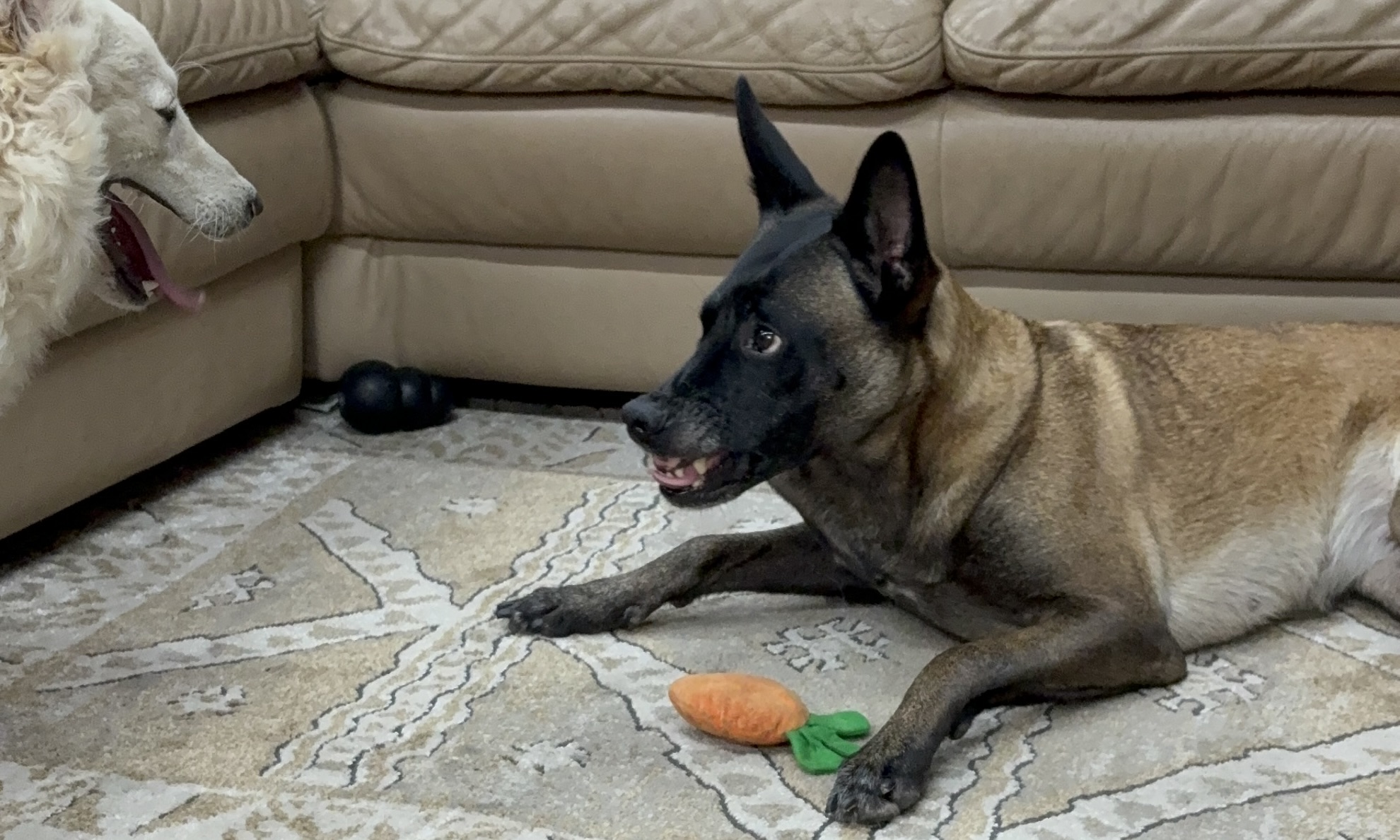Muzzles are essential pieces of safety equipment, and every dog owner should have a muzzle that fits their dog. Muzzles are not just for dogs who have a bite history, or dogs that pose a significant bite risk – but of course they are even more important for these dogs.
Muzzle training is an important skill for all dogs to learn. Every dog has the potential to bite, especially when stressed, and muzzle training is a way for us to increase safety in situations when our dogs need to be muzzled.
Many dogs struggle with vet care, nail trims, baths and grooming, meeting new people, playing politely with other dogs, traveling, or any number of other everyday situations. If your dog tends to choose mouth-oriented behaviors to deal with stress, muzzle training is a great way to keep you and your dog safe.
Muzzles are excellent for preventing bites. Once a dog learns biting is an effective coping strategy, they are far more likely to try biting again in the future. Muzzle training keeps a lid on that possibility.
Not all muzzles are created equal, and there are a variety of different types of muzzle to choose from. Choosing the right muzzle for your dog and your situation is just as important as training your dog to be tolerant of their muzzle.
Main Types of Muzzles
Basket Muzzle
- Largely regarded as the best type of muzzle for standard and long-nosed breeds
- Good for brief or extended wear
- Some designs come with anti-scavenging guards
- Highest level of protection
- Made with a variety of materials: leather, vinyl, Biothane, plastic, metal, etc
- Made in a variety of shapes and sizes, many premade and custom options
Mask Muzzle
- For short-nosed breeds only
- Suitable for extended wear
- Variety of materials, some have treat holes
- Good protection
Soft Muzzle or Sleeve Muzzle
- Good for brief wear
- Not suitable for extended wear, dog cannot pant or drink water
- Soft and comfortable, but difficult to deliver treats for training
- Moderate protection
Strap Muzzle
- Okay for very brief wear, unsafe for extended wear
- Sometimes marketed as an anti-bark muzzle (not effective)
- Does not prevent nipping or most bites
- Little to no protection (largely considered useless)
What type of muzzle is right for my dog?
Like all good questions, the only valid answer is: it depends! Looking for the best muzzle for your dog is like looking for the best pair of shoes. There are awesome muzzles out there, but if they don’t fit your dog and your situation – they’re not for you!
In general, most dogs will benefit best from a well-fitted basket muzzle in a comfortable, easy to clean material (vinyl, plastic, wire, Biothane, etc)
- What situations is your dog going to wear this muzzle in?
- If your dog is going to be exercising at all, or wearing the muzzle in warm weather – you need to choose a basket muzzle that gives your dog plenty of room to pant, drink water, and eat treats.
- If your dog is only going to be wearing the muzzle for a few minutes, and not exerting themselves (like at a vet visit or for nail trims) – you may be fine using a fabric or mesh muzzle that straps your dog’s mouth closed.
- How serious is your dog’s bite risk?
- If your dog is likely to bite using their whole mouth, or they are insistent on biting – you need a much more “bite proof” muzzle than a dog that might only nip or mouth.
- If your dog is only likely to nip or mouth, and is not a serious bite risk – you may be fine using a soft fabric muzzle, or a looser less fitted muzzle.
- How often will your dog need to wear their muzzle?
- If you will regularly rely on this muzzle, spend a little more time finding the perfect fit for your dog.
- If this is a muzzle for emergency purposes only, or very rare occasions – you can choose a muzzle that isn’t extremely comfortable or aesthetically pleasing.
- Do you want “scary dog privilege” from wearing the muzzle?
- If you want people to give you space, choosing a leather or wire basket muzzle is a good option. People are much more nervous around a dog in a serious looking muzzle!
- If you want people to feel comfortable around your dog, choosing a clear vinyl muzzle, or a muzzle with bright, happy colors may be a better option.
How do I fit a muzzle for my dog?
Muzzle fit largely depends on the manufacturer’s instructions. When we are looking at muzzle fit, here are some key points:
- Snug enough that a determined dog can’t remove it
- Large enough that your dog can pant, drink water, and take treats
- Ventilated enough that your dog can regulate their temperature via panting
- Long enough that it doesn’t press on their nose when snug
- Short enough that it doesn’t ride up into their eyes when snug
Make sure you follow the manufacturer’s instructions for muzzle measuring and sizing, as they may differ from muzzle to muzzle. A good rule of thumb to determine how much space you need for your dog to pant or drink water is to measure your dog’s muzzle circumference when they’re holding a ball in their mouth.
All things considered, the best recommendation we have if you’re unsure of sizing is to order more than one size, or order a fully custom muzzle.
Training / Conditioning Muzzles
Introducing muzzles can be tough for some dogs! One of the easiest ways is to use a training or conditioning muzzle. This is a muzzle that has had the front end cut off. Of course, this renders the muzzle useless for preventing a bite – but it makes wearing it far less frustrating.
Generally, frustration is the toughest part of muzzle training! Dogs use their mouths like we use our hands, so imagine the frustration of having your hands bound when you’re trying to get things done. It’s obnoxious!
By cutting off the front of the muzzle, you’re making sure your dog first gets comfortable with the sensation of a muzzle sitting on their face, without asking them to be fine with the frustration element. Once your dog is comfortable with a training muzzle, you can start using your normal muzzle for training!
If you plan on using a training muzzle, buy an additional muzzle for this specific purpose. If you ended up ordering two different sizes, you can use the one that doesn’t fit as well as the training muzzle.



